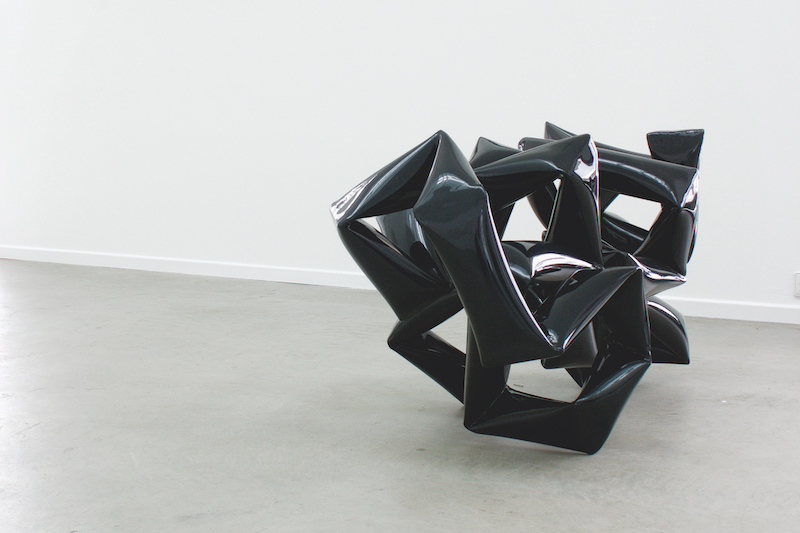Willi Siber: Free Association
Willi Siber emerged from an art history of abstraction where signifiers of story were abhorred. His practice today remains staunchly non narratorial.
Words: Prue Gibson
Born in 1949 in Eberhardzell, Germany, Willi Siber hails from an era of late modernism, when narrative was a dirty word and form or surface trumped any kind of realistic representation. Siber says, “The objects evoke varied memories. They exist independently of significant, meaningful contexts.”
The performative way we enter a gallery and engage with sculpture has shifted in recent times. As the experience of art has become more immersive and sensual, how does the work of this respected artist, who is represented by sixteen major galleries around the world, stand the test of time? Well, Siber remains inventive. He works hard to disrupt audience expectations and upset our viewing habits. He wants to surprise us and says, “These properties (distinctive haptics and optics) measure up to the beholder’s expectations of the manual or artistic way of composition. My approach of practice deliberately contradicts these expectations and familiar visual habits: I’m trying to acquire new unexpected forms of expression and appearance from the basic material.”
Siber’s sculptures comprise twisted metal forms (reminiscent of drinking straws) that defy our expectations of the possibilities of metal. These metal forms painted with enamel are highly desirable and seductive objects; they create a lively sensual experience, they demand touch. Siber’s honeycomb-like wood and emulsion works cast shadows and project outwards into gallery spaces. They are experiments with form and spatiality. He says of these sculptures: “Structures, light and colour compete with the found shape and the basic material. Within the engaged reflection confusions between form negating and shape emphasising aspects arise.”
Could Siber be a torturer? His nails and epoxy resin relief sculptures are like violent beds of nails. They play with shallow relief space, but also with matter. The surfaces, pressed against the nails or pegs, are sheer abstractions. The resin of the liquidy surface gives the appearance of biological matter or even cosmic galactic gases. These associations are not subjective but collective, in the sense of a universal catalogue of visual knowledge. However Siber refutes this position, protesting that, “my works are always free and independent objects … and won’t be narratively explained.”
Colour is a driving element for Siber. He uses it to investigate form. He says that he explores how colour and materiality act against each other during his creative process. This might mean that colour is perceived and cannot be broken down, whereas materials are endlessly divisible. Either way, the artist’s range of colours is endless. Siber asks of himself, “How can [colours] affect the set form which is first and initially the defining element? How far does the colour serve as material and formal alienation?”
As mentioned before, Siber is a product of the era in which he was born and educated. As such, he says, “I was fascinated by Wassily Kandinsky, Piet Mondrian and the development of abstract art. The appearance of pure form, colour and texture is still not complete.” This is the test of a hardy artist, because his experimentations
and investigations are not finished either. He continues to interpret new means of challenging our conscious experience of art as form. With respect to the perplexing non-chronologies of making art in a particular time, he says, “An affirmative aesthetics is always maintained. Yes I’m looking for this.”
So Siber emerged from an art history of abstraction, where interpretive meanings and signifiers of story were abhorred. His practice has been, and remains staunchly, investigative rather than narratorial. His lozenge sculptures are turned wooden forms, coated with delicious multi- coloured paints. The feel, the texture and the taste of matter are the effects. We, quite literally, want to eat his sculptures. This is a subversion of meaning and a return to the haptic and sensual experiences of the world. And yet, I suspect Siber would not be satisfied with merely one interpretation of his work. He says, “These [works] are in debt to an ambivalent appearance: immaterial and yet at present, sensual, aesthetic and yet material confessing, physically present and yet fugitive, flooded with light, untouchable.”
Conny Dietzschold
DIRECTOR, CONNY DIETZSCHOLD GALLERY, SYDNEY
Conny Dietzschold has represented the sculptor Willi Siber since 2005. She was drawn to his work because, “ [it] is so different and cannot be assigned to a particular genre. His works are like paintings and yet they find their expression and place in objects rather than a canvas. It is his rope dance of transgressing the border between painting and sculpture … his work is done in an explicit immaculate way, and the aesthetics of the materiality that he creates, the rough meets the subtle, sublime and beauty, that tension, touched my art nerve.”
Siber has extensive representation in Europe, Hong Kong, USA and Australia. His works have been exhibited in prominent museums and Kunsthalls and Kunstvereinen in Germany. Numerous works have been acquired for public collections including: German ParliamentHouse, Berlin (Deutscher Bundestag Berlin); State Ministry for Culture, State Baden-Wuerttemberg; Regional State Art Museum Spendau, Reutlingen, Germany; and the Braith-Mali- Museum, Biberach, North Rhine Westfalia, Germany.
Dietzschold comments that those acquiring his works here in Australia are “high quality collectors in Sydney and Melbourne.” His forthcoming Sydney exhibition will have works priced between $ 400 – $11,000. According to Dietzschold, Siber prices the works for Australia at 20% less than the international market. She comments further: “his market is of course in his home turf, but he has a great following here in Australia, the States and Hong Kong.”
Hannah McKissock-Davis
This article was originally published in Art Collector issue 66, OCT-DEC 2013.













